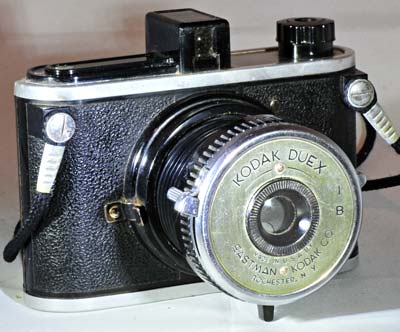Kodak Duex
Specification

| Manufacturer | : | Kodak |
|---|---|---|
| Produced | : | 1940 |
| Classification | : | Medium Format |
| Body Type | : | Extending Helix |
| Construction | : | Bakelite/Metal |
| Film Type | : | 620 |
| Film Width | : | 62mm |
| ImageSize | : | 4x6cm |
| No. of Images | : | 16 |
| Lens Type | : | Kodak Doublet |
| Focus Type | : | Fixed |
| Focal Length | : | 65mm |
| Focal Range | : | 2.75m - inf. |
| Aperture Type | : | Fixed |
| Aperture | : | f/11 |
| Shutter Type | : | Rotary |
| Shutter Speeds | : | B, I*(1/30 s) |
| Size Open (w x h x d) | : | 125 x 95 x 92 mm |
| Size Closed (w x h x d) | : | 125 x 95 x 68 mm |
| Weight | : | 375g |
| * Measured on this camera | ||
Art Deco Credentials
![]()
![]()
Acceptable: Modest and restricted
- Designed during the main Art Deco period.
- Curvilinear body design in Streamline Moderne style
- Leather pattern in Bakelite
- Curved detailing on viewfinder
- Art Deco lettering on front plate
Description
The Kodak Duex is a basic collapsible viewfinder camera with the lens plate deployed via an extending helix. Initially, the Duo was made in Germany but production was shifted to the United States as the second world war progressed.
The Duex's main feature is its helicoid lens barrel. The lens is deployed by twisting the lens plate through 360 degrees. A tab on the lens plate provides a table stand.
The rotary shutter is prevented from being fired when the camera is closed. The shutter lock is released by deploying the lens. The shutter has an instant setting of 1/30seconds. There is also a bulb setting. The duplex lens has a fixed aperture of f/11.
A simple optical viewfinder is placed in the middle of the top plate. The film winding knob is also on the top plate. On the bottom plate is a latch that allows the back of the camera to slide apart for loading and unloading 620 film. A tripod socket is also to be found on the bottom plate for landscape photos. The red window on the back of the camera does not have a cover.
How to Use
The manual for this camera can be found here :- Kodak Duex Manual
This camera takes 620 film which is still available from selected photographic outlets. Although the actual film is the same as 120 film, the spools are different. The 620 spools are slightly shorter and have a smaller diameter. Do not use 120 film in this camera because it will jam and may snap. It is possible to cut down a spool of 120 film to fit or to re-spool some 120 film onto 620 spools in a darkroom or changing bag. Don't forget to ask for your 620 spool back when getting the film developed.
Shutter speeds is 1/30s. The aperture value is f/11.
If you don't want to bother with an exposure meter, follow the guide shown. It is based on the 'Sunny 16' rule. Film is so forgiving and will produce acceptable results even when overexposed by 2 or 3 stops or underexposed by 1 stop.
Remember that the exposure guide in the camera user manual may not be helpful as it is based on the use of old film with a low ISO value.
The tables assume that the sun is at least 30 degrees above the horizon - that's 10am - 5pm on a summer's day (May-August) in the UK.
Because of the slow speed of this camera, you may need a tripod or hold the camera firmly against your face to stop blur through shake.
Don't forget to cover the red windows with black electrical tape, except when advancing the film in low light. Modern film is sensitive to red light.
Using ISO 100/125 film - shutter speed 1/30s
| Weather Conditions | Shadow Detail | Aperture | Exposure |
|---|---|---|---|
 Sunny SunnySnow/Sand | Dark with sharp edges | f/11 | +4 Stops Overexposed Not Acceptable |
 Sunny Sunny | Distinct | f/11 | +3 Stops Overexposed Acceptable |
 Slight Overcast Slight Overcast | Soft around edges | f/11 | +2 Stops Overexposed Acceptable |
 Overcast Overcast | Barely visible | f/11 | +1 Stop Overexposed Acceptable |
 Heavy Overcast Heavy Overcast | None | f/11 | Good |
 Open Shade Open Shade/Sunset | None | f/11 | -1 Stop Underexposed Acceptable |